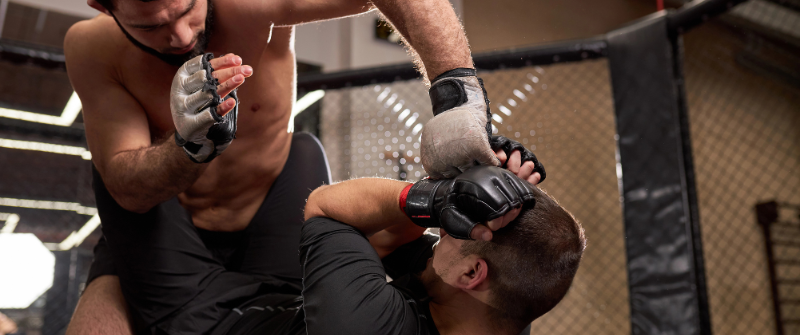.png)
- by NEXO Team
- September 22, 2025
Martial arts schools face very different risks depending on the style and how classes are taught. Karate programs often focus on structured techniques with controlled sparring, whereas MMA gyms involve higher contact training and a wider mix of disciplines. Traditional martial arts usually fall somewhere in between, with their own blend of routines and competitive elements. In the sections ahead, we’ll look at how insurers view these differences and what school owners should know to choose coverage that truly fits their needs.
Core Coverage Every Martial Arts School Needs
Before comparing Karate, MMA, and traditional martial arts coverage, it’s important to understand the core policies nearly every school needs. These form the foundation of protection, regardless of style or training approach:
General Liability Insurance: Covers claims related to injuries or accidents that happen on the premises.
Professional Liability Insurance: Protects against claims tied to instructor mistakes or allegations of negligence.
Workers’ Compensation: Provides required benefits if employees are hurt while working.
Property Coverage: Pays for repairs or replacement if mats, training gear, or the facility itself are damaged.
These basics appear in nearly every martial arts policy because most schools share similar risks at a high level. The difference comes in the coverage limits and exclusions, which insurers adjust based on the intensity and unique hazards of each discipline.
Also Read: Common Insurance Claims in Martial Arts Studios and How to Prevent Them
Karate Insurance Considerations
Karate programs typically involve moderate contact through structured sparring, kata practice, and controlled drills. While the training develops discipline and technique, the physical risks usually center on sprains, falls, or the occasional minor contact injury. Compared to full contact combat sports, the level of risk remains relatively contained, which influences how insurers view coverage needs.
Because most karate schools focus heavily on children’s classes, policies often account for the age of students when setting terms. Coverage is generally easier to obtain than it is for disciplines with more intense physical contact, and premiums tend to be lower as a result. Even so, schools still need comprehensive protection that aligns with their class structure and training style, since factors like class size or the frequency of sparring sessions may affect the limits and exclusions written into the policy.
MMA (Mixed Martial Arts) Insurance Considerations
MMA schools combine striking, grappling, and submissions in a full contact setting, so the risk profile is much higher than in most other martial arts. Concussions, fractures, and other serious injuries are far more common, which is why many insurers classify MMA as a high risk sport and write policies with stricter requirements.
Coverage for these gyms often comes with higher premiums and liability limits, along with detailed waivers for anyone stepping on the mats. Hosting tournaments or competitive events usually calls for additional event coverage as well. These factors reflect the physical intensity of MMA and the range of injuries that may occur in training or competition. Working with insurers who understand combat sports helps owners secure policies that protect both daily operations and larger events without leaving gaps that could create financial headaches later.
Also Read: Liability Insurance for Martial Arts
Traditional Martial Arts (Kung Fu, Taekwondo, Aikido, etc.)
Traditional martial arts such as Kung Fu, Taekwondo, and Aikido often center on discipline, forms, and controlled sparring. The physical risks usually involve repetitive strain injuries from drills, minor accidents during partner work, and the occasional fall. Compared to high contact sports like MMA, insurers tend to view these styles as moderate risk activities, though still more involved than low impact options like yoga or dance.
Premium costs for these schools shift depending on the training offered. Programs that incorporate weapons practice, such as bo staff or sword training, often face higher liability considerations than those focusing solely on empty hand techniques. This is because weapons classes introduce additional exposure for both students and instructors. For school owners, understanding how each part of their training program affects risk makes it easier to work with insurers and secure coverage aligned with their operations.
Specialty Coverage Needs
Beyond the core policies, many martial arts schools need coverage that addresses risks tied to specific activities. These add ons often depend on the type of training offered and how programs are structured:
Weapons Training: Many policies exclude weapons work by default, so schools offering no staff, sword, or similar training need explicit coverage to handle potential liability claims.
Tournaments and Competitions: Events bring larger crowds and increased contact risk. Separate event liability policies help protect the school from claims tied to injuries or accidents during these activities.
Travel Programs and Off Site Classes: Schools holding outdoor sessions or traveling for seminars need coverage that follows them beyond the main facility.
Sexual Abuse and Molestation (SAM) Coverage: This protection is often recommended for youth-focused schools, but it is not a policy offered through NEXO. Schools seeking it would need to explore other carriers for this coverage.
Why Premiums Differ by Martial Arts Discipline
Insurance premiums for martial arts schools depend on how insurers view the risks tied to each discipline. Styles with more frequent or severe injuries, like MMA, typically come with higher costs than those built around lighter contact or structured practice. Underwriters also look at who the school serves, since programs for kids bring different considerations than adult focused classes. Competition heavy gyms often carry added costs as well, with tournaments creating more opportunities for claims than recreational training. Taken together, these factors give insurers a clearer picture of the school’s risk level and directly influence how premiums are set for each style.
Also Read: Does Your Martial Arts Insurance Cover Training and Sparring?
Choosing the Right Insurance Partner
Working with a broker who understands the risks of martial arts schools saves owners time and prevents costly mistakes. NEXO specializes in insurance for gyms and training facilities, helping programs that blend Karate, BJJ, and MMA under one roof find coverage that matches their needs. Our team handles all of the insurance details so owners can spend more time running their business instead of managing paperwork and renewals.
As class offerings change, reviewing policies each year keeps coverage aligned with the way students train. It also gives school owners a chance to adjust liability limits or add specialty policies as programs expand into tournaments, off site classes, or weapons training. Regular reviews create a stronger fit between the coverage in place and the risks schools actually contend with, helping owners avoid gaps before they become expensive problems.
Conclusion
Not all martial arts schools carry the same risks, so coverage should never be one size fits all. The right insurance protects owners, instructors, and students while keeping programs running smoothly, no matter the discipline or class structure. To build a policy that reflects the way your school operates, consult with a fitness specific insurance provider like NEXO. Our team works directly with you to customize coverage that fits your needs and adapts as your training programs and student base grow over time. Contact us today to learn more!
Categories
Fill out a short form to contact us with your questions or to receive a customized quote.
Recent Posts
-
 NEXO’s Affinity Program: How Fitness Suppliers and Associations Can Partner for Profit and Protection
December 5, 2025
NEXO’s Affinity Program: How Fitness Suppliers and Associations Can Partner for Profit and Protection
December 5, 2025 -
%20(1).png) How to Insure an MMA Gym Without Paying for Coverage You Don’t Need
December 5, 2025
How to Insure an MMA Gym Without Paying for Coverage You Don’t Need
December 5, 2025 -
 Mastering Liability for Jiu-Jitsu Tournaments and Martial Arts Events
December 5, 2025
Mastering Liability for Jiu-Jitsu Tournaments and Martial Arts Events
December 5, 2025 -
 From Zen to Zoning: What Every Yoga and Pilates Studio Owner Should Know Before Signing a Lease
December 5, 2025
From Zen to Zoning: What Every Yoga and Pilates Studio Owner Should Know Before Signing a Lease
December 5, 2025 -
%20(1).png) Why Your Referral & Loyalty Program Can Impact Your Insurance Rates
December 5, 2025
Why Your Referral & Loyalty Program Can Impact Your Insurance Rates
December 5, 2025
